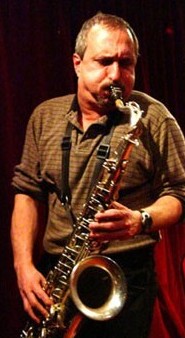George Garzone
George Garzone | |
|---|---|
 Garzone in 2007 | |
| Background information | |
| Born | September 23, 1950 Boston, Massachusetts, U.S. |
| Genres | Jazz, free jazz |
| Occupation(s) | Musician, educator |
| Instruments | Saxophone |
| Years active | 1959–present |
| Labels | Resolution, Northeastern, NYC |
| Associated acts | The Fringe, The Ayn Inserto Jazz Orchestra, Travelin' Hellhound |
| Website | georgegarzone |


George Garzone (born September 23, 1950)[1] is a saxophonist and jazz educator from Boston, Massachusetts.
Biography[]
Garzone is a member of the Fringe, a jazz trio founded in 1972 that includes bassist John Lockwood and drummer Bob Gullotti. The group has released several albums. Garzone has appeared on over 20 recordings. He began on tenor saxophone when he was six, played in a family band, and attended music school in Boston. He toured Europe with Jamaaladeen Tacuma and performed with Jack DeJohnette, Joe Lovano, John Patitucci, Danilo Pérez, Rachel Z, and Bob Weir and Ratdog.
Garzone is also a jazz educator, teaching at the Berklee College of Music, New England Conservatory, Longy School of Music, New York University, and the New School for Jazz and Contemporary Music. He pioneered the triadic chromatic approach. His students include Mindi Abair, Branford Marsalis, Donny McCaslin, Danilo Pérez, Joshua Redman, Luciana Souza, and Mark Turner.
In 1995 he recorded a tribute to Stan Getz on NYC Records called Alone. Four's and Two's followed a year later with Joe Lovano, and in 1999 Garzone returned with Moodiology. Fringe in New York was released in summer 2000. With the Joe Lovano Nonet he recorded at the Village Vanguard in September 2002.
He has also performed with Don Alias, Kenny Barron, Dennis Chambers, Stanley Cowell, Anton Fig, Dan Gottlieb, Tom Harrell, Dave Holland, Dave Liebman, Cecil McBee, Bob Moses, Gary Peacock, Marvin Smith, Bill Stewart, Harvie Swartz, and Lenny White.[2]
Triadic chromatic approach[]
The triadic chromatic approach is an improvisatory approach created by George Garzone while teaching at colleges in Boston and New York City. The approach was developed to allow the improviser to be able to improvise freely without having to concern themselves with what is going on harmonically.
This approach is applied by selecting one the four standard triads (major, minor, augmented, and diminished) and moving by a half step into another inversion of the same type of triad. This is a broad definition and there are many ways to be able to manipulate and change this approach.[3]
Discography[]
As leader[]
- Alone (NYC, 1995)
- Four's and Two's (NYC, 1995)
- Demetrio's Dream (Nel Jazz, 1996)
- Moodiology (NYC, 1999)
- The Fringe in New York (NYC, 2000)
- Onetwothreefour (Stunt, 2006)
- Night of My Beloved (Venus, 2008)
- Among Friends (Stunt, 2009)
- Filing the Profile (Intuition, 2011)
- Audacity (Challenge, 2012)[4]
- Quintonic (Stunt, 2014)
- 3 Nights in L.A. (Fuzzy Music, 2019)
With The Fringe
- The Fringe (Ap-Gu-Ga, 1978)
- Live ! (Ap-Gu-Ga, 1980)
- Hey, Open Up! (Ap-Gu-Ga, 1982)
- The Raging Bulls (Ap-Gu-Ga, 1986)
- The Return of the Neanderthal Man (Northeastern, 1990)
- It's Time for the Fringe (Soul Note, 1993)
- Live in Israel (Soul Note, 1997)
- Live in Iseo (Soul Note, 2001)
As sideman[]
- Magnus Bakken, Cycles (AMP, 2015)
- Ben Besiakov, Aviation (Stunt, 2000)
- Ben Besiakov, Hey Why Don't We Play (Stunt, 2002)
- Randy Brecker, The Avatar Sessions (Fuzzy Music, 2009)
- Claire Daly, Swing Low (Koch, 1999)
- Aydin Esen, Pictures (Bellaphon, 1989)
- Diego Figueiredo, Broken Bossa (Stunt, 2015)
- Leo Genovese, Seeds (Palmetto, 2013)
- Daniel Humair, Quatre Fois Trois (Label Bleu, 1997)
- Ingrid Jensen, Vernal Fields (Enja, 1995)
- Tom Kennedy, Just Play! (Capri, 2013)
- Brian Landrus, Forward (Cadence, 2009)
- Joe Lovano, 52nd Street Themes (Blue Note, 2000)
- Joe Lovano, On This Day...at the Vanguard (Blue Note, 2003)
- Joe Lovano, Streams of Expression (Blue Note, 2006)
- Matthias Lupri, Shadow of the Vibe (Chartmaker, 1999)
- Mike Mainieri, An American Diary (NYC, 1997)
- Bob Moses, Love Everlasting (Amulet, 1999)
- Wolfgang Muthspiel, Black & Blue (Amadeo, 1992)
- Jorn Oien, Short Stories (Resonant Music, 2004)
- Orange Then Blue, Live: Where Were You? (GM, 1989)
- Rachel Z, Room of One's Own (NYC, 1996)
- Pete Robbins, Centric (Telepathy, 2001)
- Jeff Rupert, The Ripple (Rupe Media, 2020)
- George Russell, The African Game (Blue Note, 1985)
- George Russell, So What (Blue Note, 1986)
- George Schuller, Lookin' Up from Down Below (GM, 1989)
- George Schuller, Tenor Tantrums (New World, 1999)
- Gunther Schuller, Jumpin' in the Future (GM, 1988)
- Judi Silvano, Cleome Live Takes (JSL, 2008)
- Luciana Souza, An Answer to Your Silence (NYC, 1998)
- Martin Taylor, Kiss and Tell (Columbia, 1999)
- Frank Tiberi, Tiberian Mode (NY Jam, 1999)
References[]
- ^ Gilbert, Mark (2002). "Garzone, George (Sabato)". In Barry Kernfeld (ed.). The new Grove dictionary of jazz, vol. 2 (2nd ed.). New York: Grove's Dictionaries. p. 19. ISBN 1561592846.
- ^ "Faculty - Berklee College of Music". www.berklee.edu.
- ^ http://www.downbeat.com/digitaledition/2009/DB0509/default.html
- ^ "Audacity". Challenge.
External links[]
- 1950 births
- Living people
- 21st-century American male musicians
- 21st-century saxophonists
- American jazz saxophonists
- American male jazz musicians
- American male saxophonists
- American music educators
- American people of Italian descent
- Jazz musicians from Massachusetts
- New England Conservatory faculty